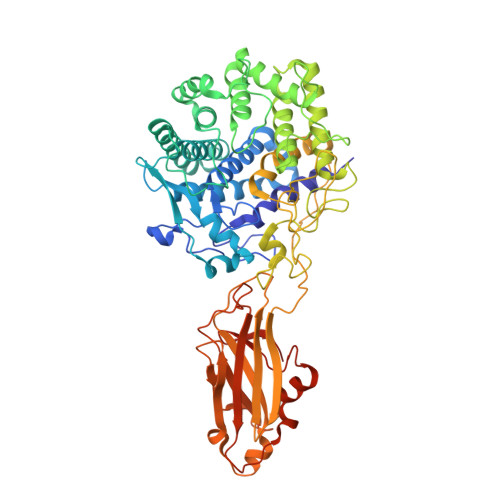Contribution of calcium ligands in substrate binding and product release in the Acetovibrio thermocellus glycoside hydrolase family 9 cellulase CelR.
Kuch, N.J., Kutschke, M.E., Parker, A., Bingman, C.A., Fox, B.G.(2023) J Biol Chem 299: 104655-104655
- PubMed: 36990218
- DOI: https://doi.org/10.1016/j.jbc.2023.104655
- Primary Citation of Related Structures:
7UNP, 7V0I, 7V0J - PubMed Abstract:
Enzymatic deconstruction of lignocellulosic biomass is crucial to establishment of the renewable biofuel and bioproduct economy. Better understanding of these enzymes, including their catalytic and binding domains, and other features offer potential avenues for improvement. Glycoside hydrolase family 9 (GH9) enzymes are attractive targets because they have members that exhibit exo- and endo-cellulolytic activity, processivity of reaction, and thermostability. This study examines a GH9 from Acetovibrio thermocellus ATCC 27405, AtCelR containing a catalytic domain and a carbohydrate binding module (CBM3c). Crystal structures of the enzyme without substrate, bound to cellohexaose (substrate) or cellobiose (product), show the positioning of ligands to calcium and adjacent residues in the catalytic domain that may contribute to substrate binding and facilitate product release. We also investigated the properties of the enzyme engineered to contain an additional carbohydrate binding module (CBM3a). Relative to the catalytic domain alone, CBM3a gave improved binding for Avicel (a crystalline form of cellulose), and catalytic efficiency (k cat /K M ) was improved 40× with both CBM3c and CBM3a present. However, because of the molecular weight added by CBM3a, the specific activity of the engineered enzyme was not increased relative to the native construct consisting of only the catalytic and CBM3c domains. This work provides new insight into a potential role of the conserved calcium in the catalytic domain and identifies contributions and limitations of domain engineering for AtCelR and perhaps other GH9 enzymes.
Organizational Affiliation:
Department of Biochemistry, University of Wisconsin-Madison, Madison, Wisconsin, USA; DOE Great Lakes Bioenergy Research Center, University of Wisconsin-Madison, Madison, Wisconsin, USA.















